Chasm Review
Symphony of the Mines.
This article first appeared on USgamer, a partner publication of VG247. Some content, such as this article, has been migrated to VG247 for posterity after USgamer's closure - but it has not been edited or further vetted by the VG247 team.
I remember seeing Chasm at one of my first PAX shows. I don't quite recall which show it was, but at the time I remember thinking, "This is going to be a winner when it finally comes out." That was at least four years ago and I wrote a preview for the game back in 2015, so I've been waiting a while to see what the developer would deliver.
Chasm places you in the training armor of a nameless scrub that's finally risen from his drudgery to become a Guildean Knight. For your first assignment, you're dispatched alone to the remote mining town of Karthas. The folks in the town are all missing and it's up to you to dive into the mines and figure out where they went. (This seems a bit much for a newly-minted knight, but it's not my organization.)
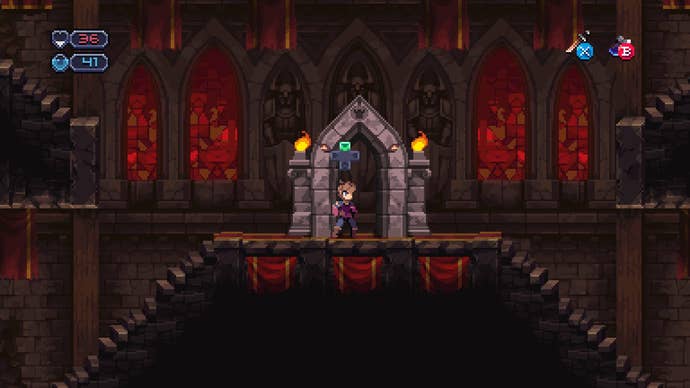
Chasm is a title you can slot firmly under the Metroidvania genre, one that crafts its overall map using procedural generation. If the genre is a favorite of yours, you've probably played a number of games like that: Rogue Legacy, Sundered, and the upcoming Dead Cells are all built on roughly the same concept. This is well-mined territory, especially when it comes to indies, but don't close this review yet! What Chasm is not is a roguelike. It doesn't have you starting from a hub area, exploring outward, dying, and then exploring yet another newly-generated map.
Instead, Chasm generates a different campaign map every time you begin a new game. The map is then set in stone for that campaign; you won't see it shift or change. The maps themselves are built from random seeds, text codes that you can share with others to allow them to play your map. New game, new map, but otherwise, you're rocking the same map until you finish.
This means Chasm offers replayable variety, but each map leans heavily on exploration and memorization, like a classic Metroid of Castlevania title. As you gain new abilities, you'll find yourself going back to older areas to see if your new ability is what you need to move forward. The abilities themselves come from Artifacts, items you'll find at various parts of your journey. Most of them have names unique to Chasm, but what they do will be rather familiar to veteran players.
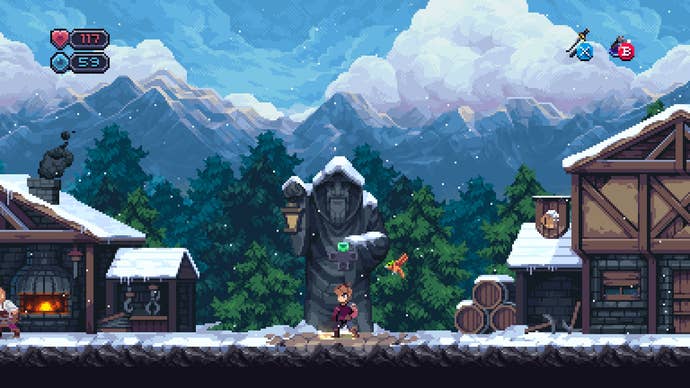
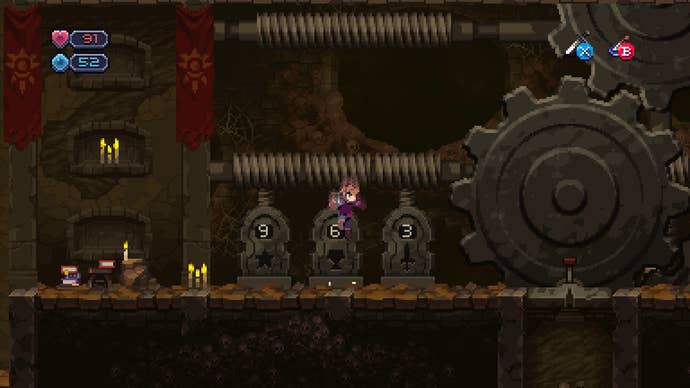
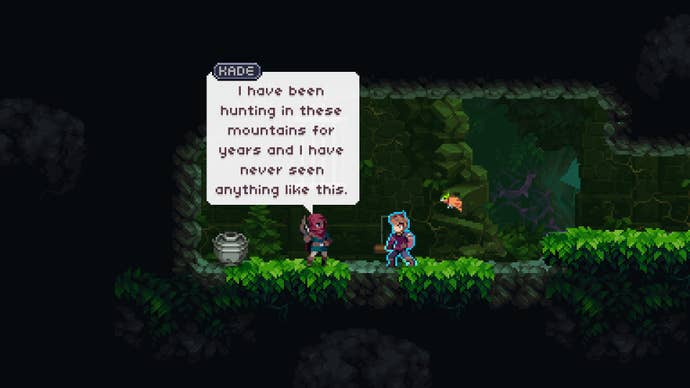

For example, the Climbing Gear is Chasm's version of the wall jump, allowing you to slide down a wall and bounce off parallel walls to scale mineshafts. Once you find the Shin Guards, you can hit down and the jump button to slide through thin passages. The Lantern lights your way forward in rooms without their own light sources. Each Artifact is pretty straightforward and combined with the static map, finding one will have you going, "Oh, I need to use this at that room back in the Gardens," even if you don't remember exactly which room it is. It makes Chasm feel like the entire map is hand-crafted, even if each new playthrough is different.
Another point of divergence from the previously-mentioned indie Metroidvanias is the focus on traversal, not combat. There is combat in Chasm, with a ton of enemies, mid-bosses, and bosses gating certain areas, but it's clear that the game was designed to challenge players more in terms of getting around. You'll run into many rooms with moving platforms, disappearing platforms, traps, timed jumps, and various environmental hazards. Enemies will be placed in such a way to knock you directly back into many of these hazards. Precise platforming is needed more than combat prowess in Chasm.
It's a bit of a shame then that there's just a tiny bit of imprecision introduced as you gain more moves and the environment changes. I found that sometimes I wouldn't grab a vine, despite feeling like I pressed Up on the directional pad at the correct time. The ledge hang and wall slide moves would also get a bit jumbled. Sometimes I wanted to hang on a ledge, not walljump, and the difference where I landed on a wall's hitbox, which feels a bit random at times.
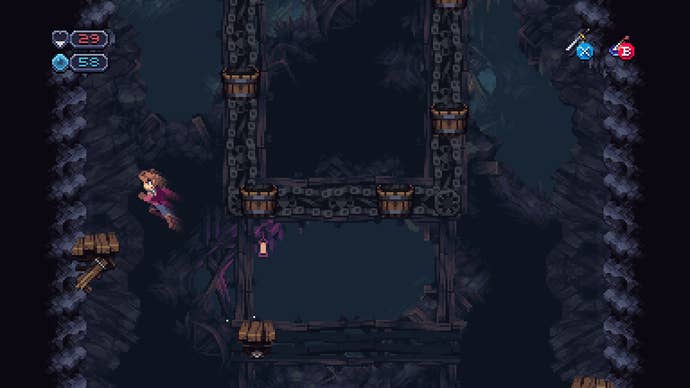
The combat ability is more of a function of time played. Being able to tackle bosses and mobs with your own skill will save you resources like healing items, but it's not as important. As you kill lowly kobolds, wasps, and the undead, you'll gain experience and levels. You'll also find various equipment to increase your stats, which is separated out into Main Hand, Off Hand, Head, Body, and Accessory slots. Main Hand weapons are the physical items you swing around, comprised of swords, whips, hammers, and whatnot. Off Hand weapons are magic-based, drawing from your MP gauge.
Here again, I have a slight issue: it feels like more loot could be dropping from enemies during the game. I found enemy drops lean on food and gold, while many of my weapons were from the Blacksmith. Upping the rate of loot from enemies would offer more reasons to kill enemies in specific sections of the game. When an enemy did drop a weapon or equipment, it feels satisfying. In contrast, some of the enemies drop nothing at all, as noted in the game's Bestiary.
Some games wear their inspiration on their sleeves and it's clear that Chasm's creators were smitten with the Castlevania series, particularly Symphony of the Night. There's nothing wrong with that—especially because we're not really swimming in actual Castlevania games—but it's noticeable. Many of the Off Hand Magic weapons feel like they're drawn directly from Castlevania's sub-weapons. These items include the Knife and Axe, which operate like Castlevania's Dagger and Axe. There's the Magic Molotov, which burns a spot when thrown, like Holy Water. There's even the Magic Shield, which works somewhat like the Bible sub-weapon.
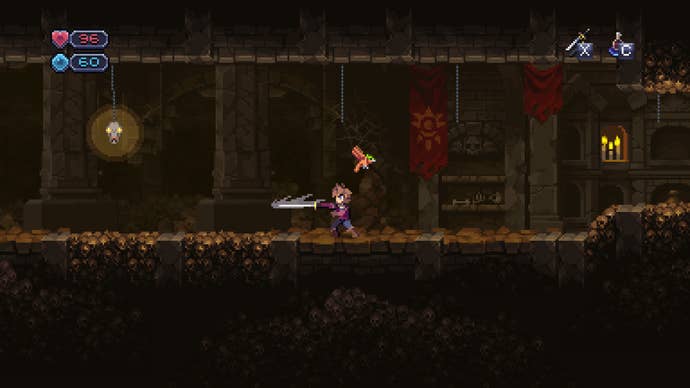
The influence feels stronger than just the sub-weapons though. Some of the Main Hand weapons look and feel like Alucard's melee weapons from Symphony of the Night. Your character leaves afterimages when he jumps and comes complete with a handy backdash and low-diagonal attack. There's a hat that gives you a tiny bird that will occasionally attack enemies, not unlike the Bat Familiar in Symphony of the Night. The levels themselves are also full of handy destructible light sources that drop bags of gold and previous MP. All in all, Chasm feels closer to the Castlevania games that inspired it than some of its indie competitors.
You'll venture out from Chasm's hub area, the town of Karthas. While your primary mission is to figure out what eldritch evil is trying to rise again, you're also down there to find the missing townsfolk. As you find people down below, they'll return to the town to offer up new shops and capabilities. You can't buy weapons or craft new armor if the town Blacksmith isn't back yet! Some of the townspeople also have unlockable tiers: the old lady who sells you magic spells can eventually upgrade those spells if you find her creepy Book of Incantations.
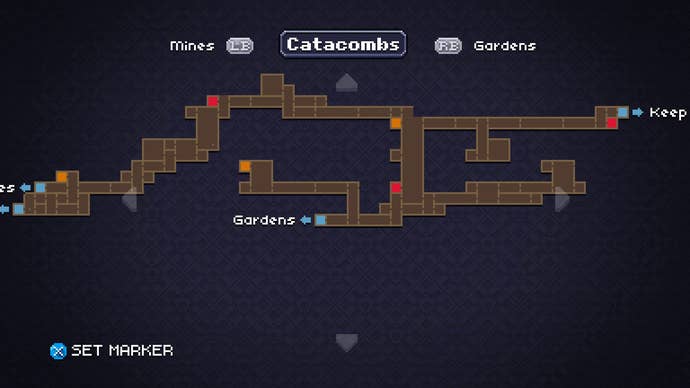
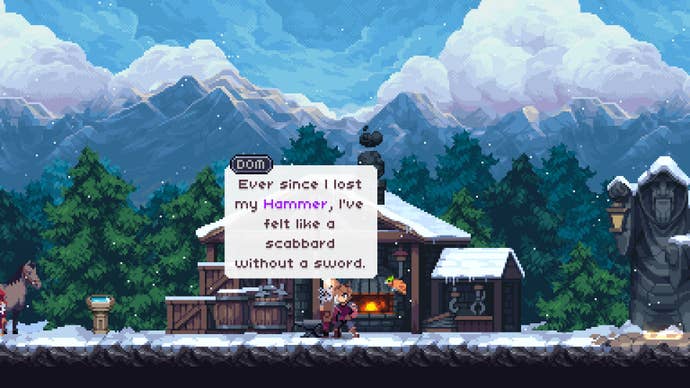

You're prevented from venturing too far in Chasm by your own mortality. Again, it isn't a roguelike; when you die, you die. There are statues in the town and underground that will save your progress and refill your health. In-between those statues, you have to rely on food and potions to keep your health topped off. If you die, you'll get a 'Game Over' screen and have to restart at your last save point. You have a single save per game, so saving in a good spot is key. There's a great deal of tension knowing that you've delved to a decent spot, only to realize the closest save room is many corridors away, you're out of health items, and there's a host of monsters and hazards on the way back.
How hard the game punishes you in terms of mobs is dependent on which difficulty level you play on. I banged through the game on Normal, but Chasm also offers Easy, Hard, Nightmare, and Mortal modes. Nightmare and Mortal are unlockable, as only Easy, Normal, and Hard are available when you first boot up Chasm. Mortal is the permadeath mode hardcore players are always looking for: if you die once, that run is completely over. I found my first runthrough was around 11 hours, which is right in line with the developer's 10-15 hour range for the average campaign run.

Everything Chasm does in terms of play is backed up by an excellent pixel art presentation and a solid soundtrack. (I'd almost say "great soundtrack", but Octopath has spoiled me on that end recently.) There's around six different biomes, each with their own unique look, hazards, and enemy types. It all comes together just right, creating an experience that was hard to put down once I was on a good run.
The major problem is that Chasm has been a long time coming and in certain areas, the game has been outperformed already. Hollow Knight did the Metroidvania thing last year with well-designed levels and beautiful hand-drawn art. Dead Cells' animation and combat are simply top-notch, even in Early Access. There's still room for Chasm to make its mark as a fun entry in the genre though. It's a game that rewards multiple playthroughs with a sense of variety, while still having a map that feels purposeful. It might not be the most unique selling point, but it's still a good one.
ConclusionWhile Chasm is an indie Metroidvania title using procedural generation, this isn't another roguelike. Instead, Chasm generates a new map with every campaign for re-playable variety. During the campaign the map stays put, promoting exploration and memorization. Chasm is all about getting around: finding new abilities to open a new path forward and overcoming difficult platforming challenges. Chasm might have been outdone in certain aspects during its five years in development, but what's here is still very good.









